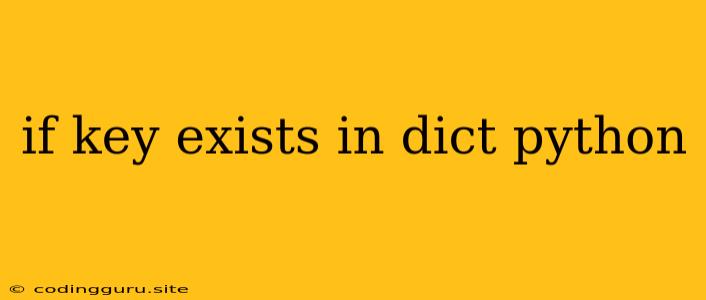Checking if a Key Exists in a Python Dictionary: A Comprehensive Guide
Working with dictionaries in Python is a fundamental aspect of data manipulation. Often, you need to determine if a particular key already exists within your dictionary before performing any operations. This article will guide you through the various methods for efficiently checking if a key exists in a Python dictionary.
Why Check for Key Existence?
Before diving into the methods, let's understand why it's crucial to check for key existence in your dictionaries.
- Preventing KeyError Exceptions: Trying to access a non-existent key in a dictionary directly will result in a
KeyError, disrupting your program flow. - Maintaining Code Integrity: Checking for keys ensures that your operations on the dictionary are safe and predictable.
- Optimizing Performance: Knowing if a key exists can prevent unnecessary operations and improve the efficiency of your code.
Effective Techniques for Checking Key Existence
Here's a breakdown of the most common and efficient ways to check if a key is present in a Python dictionary:
1. Using the in Keyword
This is the most straightforward and recommended approach. The in keyword lets you directly test if a key is present within the dictionary.
my_dict = {"name": "Alice", "age": 30}
if "name" in my_dict:
print("Key 'name' exists!")
else:
print("Key 'name' does not exist.")
if "city" in my_dict:
print("Key 'city' exists!")
else:
print("Key 'city' does not exist.")
Output:
Key 'name' exists!
Key 'city' does not exist.
2. Utilizing dict.get()
The get() method provides a versatile and elegant way to check for key existence while simultaneously retrieving the corresponding value. If the key doesn't exist, it returns a default value (which you can specify).
my_dict = {"name": "Alice", "age": 30}
name = my_dict.get("name")
print(f"Name: {name}") # Output: Name: Alice
city = my_dict.get("city", "Unknown")
print(f"City: {city}") # Output: City: Unknown
3. Using the dict.keys() Method
While less common, you can also check for key existence by iterating through the keys returned by the keys() method.
my_dict = {"name": "Alice", "age": 30}
for key in my_dict.keys():
if key == "name":
print("Key 'name' exists!")
4. Employing dict.items()
Similar to dict.keys(), you can use dict.items() to iterate through key-value pairs, allowing you to check for keys based on their values.
my_dict = {"name": "Alice", "age": 30}
for key, value in my_dict.items():
if key == "name":
print("Key 'name' exists!")
5. Checking with try...except Block (Not Recommended)
While it's possible to use a try...except block to catch KeyError, this approach is generally not recommended as it can be less efficient and less readable.
my_dict = {"name": "Alice", "age": 30}
try:
name = my_dict["name"]
print("Key 'name' exists!")
except KeyError:
print("Key 'name' does not exist.")
Best Practices for Checking Key Existence
- Prioritize Clarity and Readability: The
inkeyword is typically the most straightforward and readable option for checking key existence. - Leverage
dict.get()for Value Retrieval: If you need to retrieve the value associated with the key,dict.get()offers a more concise and efficient approach. - Avoid
try...exceptfor Key Existence: While technically possible, it's generally better to use more direct and explicit methods for better code readability and performance.
Conclusion
Knowing how to check for key existence in Python dictionaries is essential for writing robust and efficient code. By utilizing the techniques discussed in this guide, you can ensure your dictionaries are handled correctly and your programs run smoothly. Remember to prioritize the clarity and readability of your code, especially when dealing with data structures like dictionaries.
